Labradorite Gemstone: Properties, Meanings, Value & More
 Labradorite is a feldspar gemstone known for displaying a stunning internal iridescence called “labradorescence,” a type of adularescence. This feature is sometimes called “schiller.”
Labradorite is a feldspar gemstone known for displaying a stunning internal iridescence called “labradorescence,” a type of adularescence. This feature is sometimes called “schiller.”
Sorry dog lovers, but labradorite is not named after the dog breed. Rather, it’s named after Labrador, Canada. In fact, labradorite is the official mineral of Labrador and its province, Newfoundland.
You may recognize “feldspar” from other gems in this family like amazonite, orthoclase, sunstone, and moonstone. Many sunstones actually classify as labradorite! One such example is Oregon sunstone, which shows a metallic glittering effect called aventurescence. After orthoclase, labradorite is the feldspar gem you’ll most often see faceted.
Besides Oregon sunstone, labradorite has a few other subtypes. Today, we’ll cover those varieties, along with labradorite properties, healing uses, symbolism, and all your other questions about labradorite gemstones!
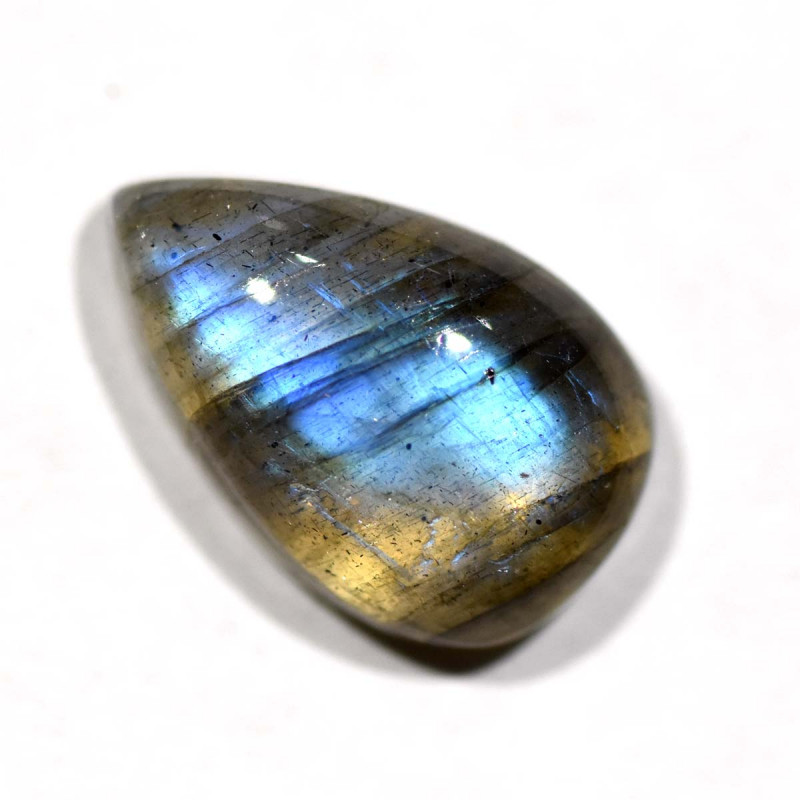
About Labradorite Stone
First, is labradorite a precious gemstone? No, labradorite is a semi-precious gemstone. The only gemstones considered “precious gemstones” are diamonds, sapphires, rubies, and emeralds. However, labradorite can be a lucky talisman!
What birthstone is labradorite? Labradorite is an alternative November birthstone and a phenomenal birthstone for those born on a Saturday.
Astrologically, labradorite zodiac stones grace the sign of Cancer, and the labradorite variety spectrolite is lucky for Scorpio, Sagittarius, and Leo. The labradorite planet is Uranus or Pluto, though some astrologers recommend wearing labradorite during significant Venus phases.
Mineral Characteristics
Labradorite is an anorthite plagioclase feldspar mineral composed of sodium, calcium, aluminum, and silicon. Its sodium content varies from 30-50 percent and its calcium content varies from 50-70 percent. The stone is composed of anorthite and albite feldspar, but its composition is 50-70 percent anorthite and only 30-50 percent albite.
The feldspar mineral family is complex, but the two most common categories are plagioclase and alkali feldspars. Among plagioclase feldspars, labradorite is the only mineral to show intense schiller.
On the Mohs mineral hardness scale, labradorite ranks from 6 to 6.5. Labradorite stones are typically white, gray, yellow, or colorless, but their labradorescence is where they really shine — literally! Any color in the rainbow can flash from within labradorite, but blues and oranges are most common.
One important note: Not all labradorite stones show labradorescence. Some may show no optical effects, while others may only show a blueish-white aventurescence.
Speaking of varieties, let’s go over the subtypes of labradorite!
 Pictured above: spectrolite
Pictured above: spectrolite
Types of Labradorite
There are three notable varieties of labradorite: spectrolite, andesine-labradorite, and rainbow moonstone.
Spectrolite. A trade name for the rare Finnish variety of labradorite with a full rainbow of iridescent colors resembling the Northern Lights.
Andesine-Labradorite. A brown, peach, orange, or red opaque mixture of andesine and labradorite first discovered in 2003. May also refer to color-enhanced labradorite.
Rainbow Moonstone. Translucent to transparent white labradorite with intense, blue schiller that’s found in Madagascar, giving it the moniker “Madagascar Moonstone.”
Is labradorite a moonstone? Despite rainbow moonstone’s misleading name, labradorite and moonstone are different gems. They’re both feldspar minerals with iridescence but differ in two key ways:
Composition: Labradorite is a plagioclase feldspar, and moonstone is a gem-quality orthoclase feldspar.
Optical Effect: Labradorite is known for its varied, internal iridescence, while moonstone has a milky internal iridescence only in blue or white.
Read the rest of labradorite’s geological properties below!
Labradorite Specifications & Characteristics
Color: Typically colorless, white, yellow, or gray; May show red, orange, yellow, green, blue, and violet color flashes of labradorescence
Crystal structure: Triclinic
Luster: Pearly or vitreous (glass-like)
Transparency: Transparent to opaque
Refractive index: 1.52-1.57
Density: 2.68-2.72
Cleavage: Perfect in two directions
Fracture: Uneven
Streak: White
Luminescence: May show fluorescence; red in SW-UV, light blue or violet-blue in LW-UV
Pleochroism: Present and notable in Oregon labradorite
You know the mineralogy, but what is the meaning of the labradorite crystal?
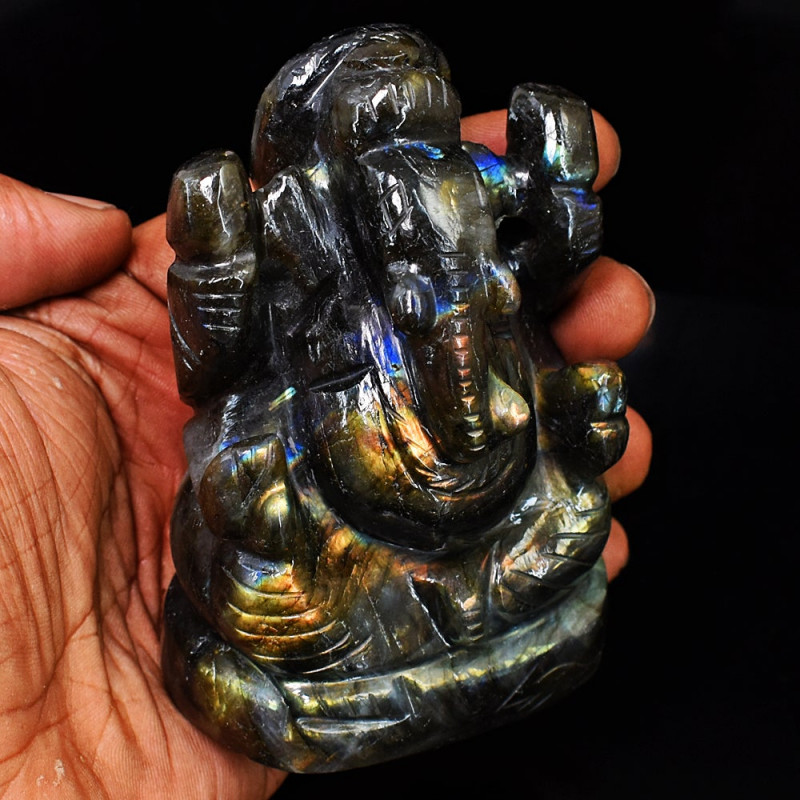
Labradorite Meaning
Labradorite’s name comes from where it was first discovered in 1770: Labrador, Canada. Labradorite’s spiritual meaning has led to nicknames like “Stone of Magic” and “Aurora Borealis Gemstone.”
So, what does labradorite symbolize? Labradorite symbolizes transformation, particularly the determination and resilience needed when going through change. Spectrolite is also said to represent the “Temple of the Stars,” a supposed ancient structure in England mapping the stars.
On that note, labradorite has some folklore surrounding it. One Inuit labradorite legend claims the Northern Lights (Aurora Borealis) were stuck inside labradorite, waiting for Inuit and Beothuk peoples to discover them so they could be released into the sky.
Finland’s spectrolite is nicknamed the “Stone of Light” and legends say it brings greater intuition, confidence, and passion. Some Finns believe labradorite represents the rainbow “Bifrost Bridge” connecting Earth to Asgard, where gods reside in Norse mythology.
We know what it means spiritually, but what does labradorite do spiritually? Let’s take a look at labradorite crystal properties for healing.
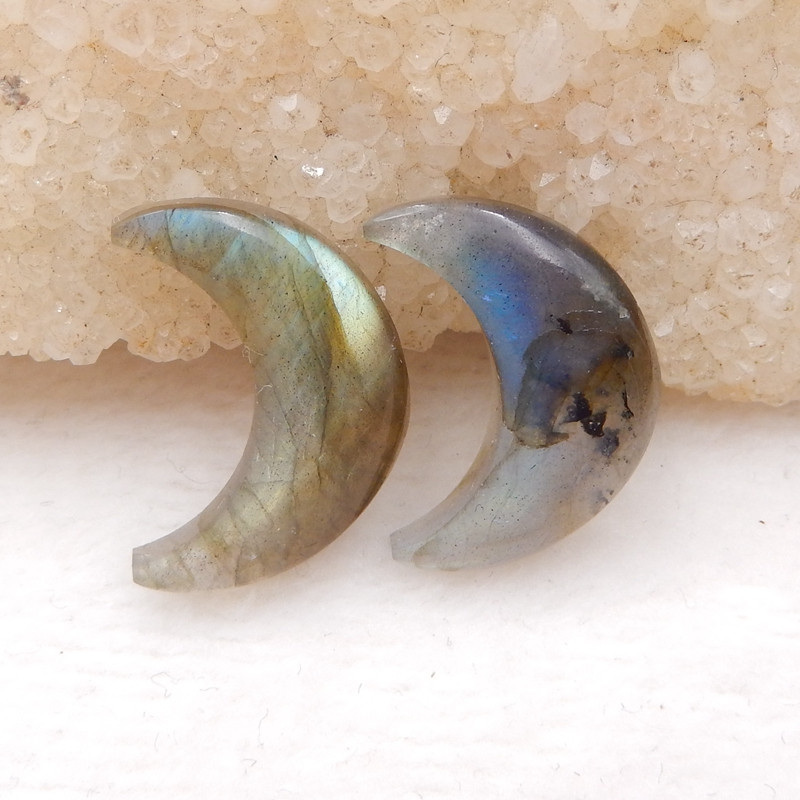
Labradorite Healing Properties
All gemstones have energies that make them beneficial healing stones, and that includes labradorite! As a primarily blue gemstone in its color flashes, labradorite inherently brings relaxing energies to wash worries away.
Overall, labradorite crystal is said to be a protective guardian, warding off negativity both externally and internally. Some say it eases self-sabotage, enabling you to pursue your dreams.
For more specific healing, what is labradorite stone used for?
Physical Healing
Physically, labradorite reportedly helps treat brain and eye disorders and high blood pressure. Other purported benefits include lowering cold sensitivity, relieving menstrual pain, and supporting healthy digestion.
Emotional Healing
Emotional healing uses for labradorite may include reducing fear, easing stress, and increasing self-worth. Labradorite can also enhance your best personality traits!
Labradorite benefits in the workplace can lower animosity and encourage empathy, creating a more welcoming, collaborative environment.
Chakra Healing
Labradorite chakra stones work best with the third eye (brow) chakra or throat chakra.
The third eye chakra is where you understand the world on a deeper, more spiritual level. When it's blocked, you may feel passive or reactive. Labradorite can open it again, bringing you insight and connection to divine wisdom.
The throat chakra governs how you understand yourself and communicate. Feeling anxious or timid are signs of a blockage. Once you open the chakra with labradorite, you can experience greater self-awareness and easier communication.
Now that you know why you should wear labradorite for healing, let’s discuss what to look for when buying labradorite jewelry.

Labradorite Gemstone Properties
Experts determine a gemstone’s value based on its value factors or gemstone properties. Labradorite’s factors include color/iridescence, clarity/transparency, cut, and treatments.
Color & Iridescence
Labradorite’s body color is often medium to dark gray, black, or brown. The dark background creates a vivid contrast for the iridescence to shine.
The most common iridescence colors in labradorite are blues and greens, though you may see red, orange, or yellow as well. Rarer (and higher-valued) color flashes are purple, white, and pink-copper hues.
The highest-valued iridescence is consistent, saturated, and diverse in color range. Sometimes, labradorescence has a “blinds” effect, where flashes seem to flutter in and out as the stone is moved.
The reason for labradorite’s iridescence comes down to its inclusions.
Clarity & Transparency
Labradorite clarity (amount and visibility of inclusions) falls under a Type II colored gemstone clarity grade, meaning you’ll usually see some visible inclusions. Labradorite’s inclusions contribute to its play-of-color, as light reflects from layers of tiny impurities.
Common inclusions include zircon, magnetite, rutile tablets, and ilmenite. In colorless, transparent labradorite, you’ll often see dark, thread-like inclusions.
Most labradorite stones are translucent to opaque. Interestingly, both opaque and transparent labradorite gems don’t show labradorescence well, so translucent specimens are best.

Cut
Transparent labradorite specimens may be faceted for the best sparkle, mostly in round or oval cuts. However, labradorite most often becomes cabochons, carvings, or beads. Labradorite-rich anorthosite rocks may be cut into slabs for architectural uses.
So, considering labradorite’s renowned prestige as a vibrantly colored gem, are its colors natural or treated?
Treatments
Jewelers may employ two treatments for labradorite: diffusion and lattice diffusion.
Diffusion treatment involves letting chemicals soak into the stone’s surface while heating it in a furnace, usually for a week or so. Lattice diffusion is almost the same, but chemical elements penetrate the stone on an atomic level. Both treatments result in a richer or new color, but lattice diffusion is stabler.
Gemstone treatments should always be disclosed to the buyer, but if you’re worried your “untreated” gem was mislabeled, you can test it for diffusion treatments.

Labradorite History
Long ago, labradorite was known to the Red Paint People of Maine, a pre-Columbian group indigenous to the Northeast area of North America. Archeologists uncovered labradorite artifacts dating back to pre-1000 CE in the group’s burial sites.
The first official discovery of labradorite occurred on St. Paul’s Island in 1770 when Moravian missionaries found the stone near Nain. There’s some evidence that ancient Inuit tribes knew of labradorite before the discovery, though.
Spectrolite’s discovery happened in 1940. Finnish geologist and professor Aarne Laitakari searched for decades to find the Finnish labradorite “mother rock” with little success. During WWII, Laitakari’s son Pekka was building fortifications in Ylämaa when he stumbled upon the first known spectrolite deposit.
Pekka sent Aarne the new specimens, confirming his search for the “mother rock” was not in vain. Jeweler Walter Mikkola suggested the name “spectrolite” (for the stone’s color spectrum) to Professor Laitakari.
Later in 1975, Newfoundland and Labrador officials designated labradorite as their official mineral. In 1988, the Finnish Tourist Board named spectrolite the South Karelia Region’s provincial stone.
What a rich history! But before it's discovered, how does labradorite form?
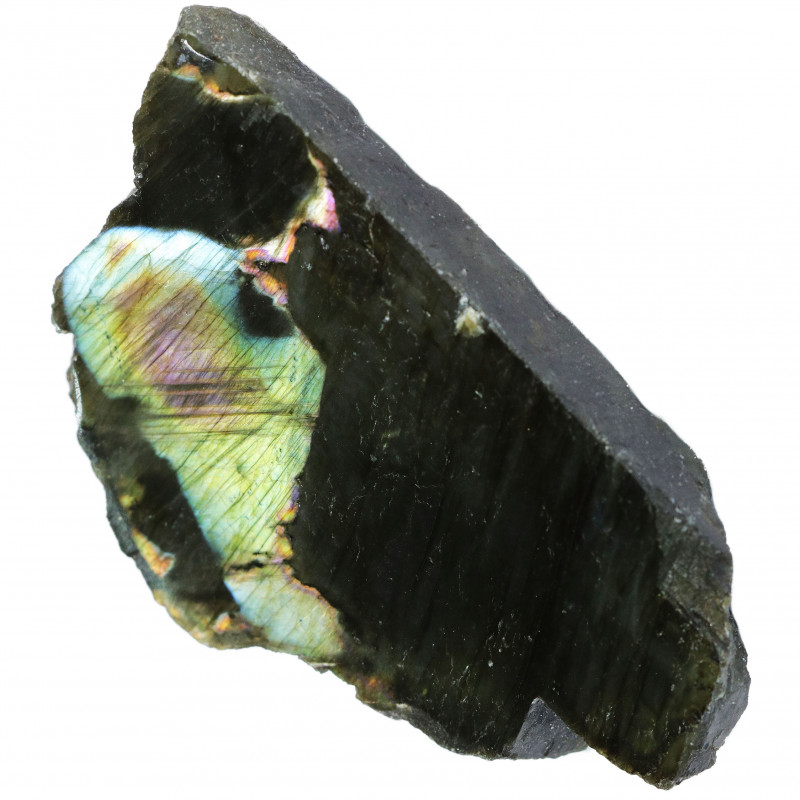
Labradorite Stone Origins & Sources
Labradorite raw stone forms in all three types of rocks: igneous, metamorphic, and sedimentary. Labradorite is usually within basalt, gabbro, norite, or anorthosite, a rock almost entirely composed of labradorite.
Labradorite-bearing igneous rocks like anorthosite may metamorphose into gneiss, another source of labradorite, or undergo weathering to create sediments where labradorite is also found.
While labradorite has a crystal structure, it rarely forms full-on crystals. Miners usually find labradorite in chunks or fragments. However, the stone’s crystal structure formation is crucial for displaying labradorescence.
The stone forms in thin, tightly stacked layers. When light hits the stone, the layers absorb, diffuse, or reflect the light, shining it back to us in various colors.
Once it forms, where is labradorite found?
Mining Locations
Currently, Madagascar is the most abundant source of labradorite. Finland, Canada, and the USA all have significant deposits, too. Rare transparent specimens come from Oregon (USA) and India.
Other labradorite locales include:
Australia
China
France
Germany
Greenland
Iceland
Italy
Japan
Norway
Russia
Slovakia
Spain
Sri Lanka
USA: Arizona, California, Maine, Nevada, New Mexico, Oregon, Utah
United Kingdom
This stone has lots of producers, but is labradorite expensive?
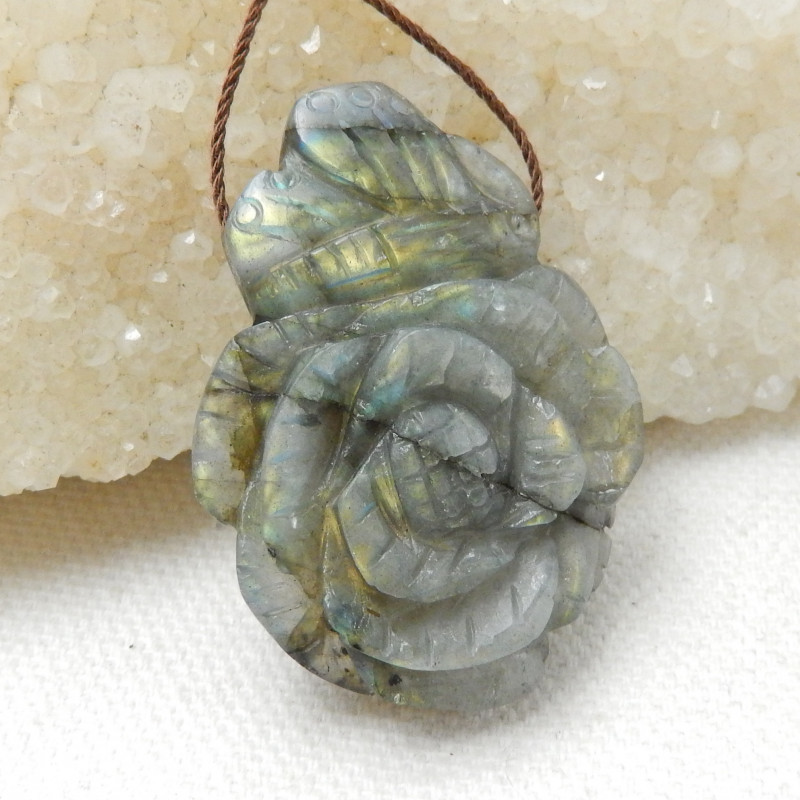
Labradorite Price & Value
As a mineral, Labradorite is abundant, but most of the material mined isn’t gem-quality. Most labradorite jewelry is also custom, not mass-produced, meaning higher prices.
When assessing labradorite gemstone value, look for iridescent clarity, saturated colors, multiple colors, and a dark background. High-quality labradorites hitting these marks are typically $40 per carat or higher.
The labradorite price per carat is lower for stones with blue labradorescence, with these cabochons selling for $2-$5 per carat. Red labradorescence is very rare, sometimes sold for $1,000 per carat or higher!
If you’re wondering how to spot a fake labradorite stone, examine the iridescence during rotation. If the color flashes appear at every angle, it’s probably a fake.
Labradorite Care and Maintenance
Labradorite’s mid-range hardness and perfect cleavage mean you must handle it with care. Bumping a labradorite ring at the right angle could break the stone, so look for jewelry with protective settings.
To clean labradorite, use mild soap, warm water, and a soft brush. Then rinse it, dry it with a microfiber cloth, and store it separately from other gemstones.
Remove labradorite jewelry before doing any activity — cleaning, makeup, etc. — that could expose it to damaging chemicals.

Ready to Delight with Labradorite?
Given labradorite’s unique iridescence and rich lore, it’s no wonder jewelry designers craft it into exquisite pieces. You can invite confidence and positivity into your life with a labradorite tower in your room or a labradorite crystal necklace around your neck!
However you use it, labradorite is a protective, encouraging companion that reminds you that thunder and hardships only mean a rainbow is around the corner.
Buy labradorite gemstones today!
Was this article helpful?
Ross Sedawie
- Written - 16th Jan 2022
- Edited - 1st Aug 2023















